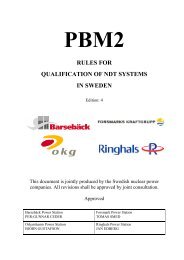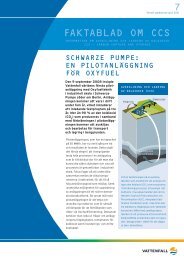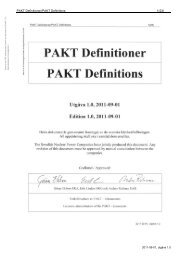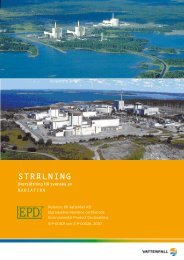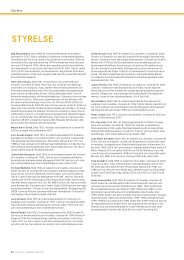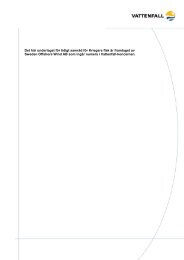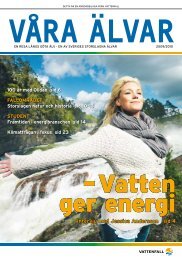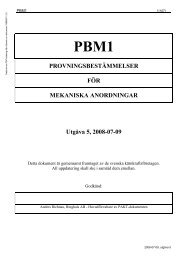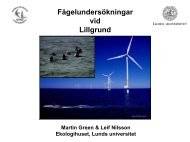Birds in southern Öresund in relation to the wind farm at ... - Vattenfall
Birds in southern Öresund in relation to the wind farm at ... - Vattenfall
Birds in southern Öresund in relation to the wind farm at ... - Vattenfall
Create successful ePaper yourself
Turn your PDF publications into a flip-book with our unique Google optimized e-Paper software.
The number of aerial surveys undertaken <strong>in</strong> different months and years are <strong>to</strong> be seen <strong>in</strong><br />
Table 1. Gaps <strong>in</strong> <strong>the</strong> coverage was due <strong>to</strong> difficult fly<strong>in</strong>g conditions, <strong>the</strong> aerial surveys also<br />
be<strong>in</strong>g dependent on <strong>the</strong> availability of suitable aircraft <strong>in</strong> <strong>the</strong> region.<br />
Analysis of survey d<strong>at</strong>a<br />
For <strong>the</strong> five most common species (Cormorant, Long-tailed Duck, Eider, Red-breasted<br />
Merganser and Herr<strong>in</strong>g Gull) comparisons of <strong>the</strong> utiliz<strong>at</strong>ion of <strong>the</strong> Lillgrund area before and<br />
after <strong>the</strong> construction of <strong>the</strong> w<strong>in</strong>d <strong>farm</strong> was analyzed us<strong>in</strong>g two methods: with Jacob’s <strong>in</strong>dex<br />
and by compar<strong>in</strong>g densities. For <strong>the</strong>se analyses we used three different zones: <strong>the</strong> w<strong>in</strong>d <strong>farm</strong><br />
area, a buffer zone of 2 km around <strong>the</strong> outer limits of <strong>the</strong> w<strong>in</strong>d <strong>farm</strong> and <strong>the</strong> outer area, i.e. <strong>the</strong><br />
nor<strong>the</strong>rn area <strong>in</strong> general exclud<strong>in</strong>g <strong>the</strong> w<strong>in</strong>d<strong>farm</strong> and buffer zone. In <strong>the</strong> aerial surveys we<br />
considered l<strong>in</strong>es 1 – 9 <strong>to</strong> constitute <strong>the</strong> nor<strong>the</strong>rn area. In <strong>the</strong> density calcul<strong>at</strong>ions we restricted<br />
<strong>the</strong> analysis <strong>to</strong> <strong>the</strong> parts of <strong>the</strong> survey l<strong>in</strong>es th<strong>at</strong> covered w<strong>at</strong>er deeper than three meter (see<br />
Fig. 6). The same area divisions were used below <strong>in</strong> <strong>the</strong> calcul<strong>at</strong>ions of Jacob’s <strong>in</strong>dex. The<br />
<strong>to</strong>tal areas of <strong>the</strong> three different zones were: w<strong>in</strong>d<strong>farm</strong> area 5 km 2 , buffer zone 29 km 2 and for<br />
<strong>the</strong> outer area 224 km 2 , of which 20%, 15% and 15 % were actually covered by <strong>the</strong> aerial<br />
surveys.<br />
The Jacob’s <strong>in</strong>dices show <strong>the</strong> rel<strong>at</strong>ive use of <strong>the</strong> different zones <strong>in</strong> <strong>rel<strong>at</strong>ion</strong> <strong>to</strong> expected use.<br />
Densities are just a measure of <strong>the</strong> number of birds per area unit. Hence <strong>the</strong> two measures <strong>in</strong><br />
part describe different th<strong>in</strong>gs and results from <strong>the</strong> two may differ. Jacob’s <strong>in</strong>dices do not give<br />
any <strong>in</strong>form<strong>at</strong>ion <strong>at</strong> all about <strong>the</strong> absolute numbers or densities of birds us<strong>in</strong>g a specific zone,<br />
but <strong>in</strong>stead show <strong>the</strong> proportion of birds us<strong>in</strong>g <strong>the</strong> zone <strong>in</strong> <strong>rel<strong>at</strong>ion</strong> <strong>to</strong> a) <strong>the</strong> <strong>to</strong>tal number of<br />
birds us<strong>in</strong>g <strong>the</strong> whole study area (all zones) and b) <strong>the</strong> proportion of <strong>the</strong> zone out of <strong>the</strong><br />
whole study area. This means th<strong>at</strong> it may very well be so th<strong>at</strong> densities <strong>in</strong> a specific zone can<br />
<strong>in</strong>crease <strong>at</strong> <strong>the</strong> same time as <strong>the</strong> Jacob’s <strong>in</strong>dex for th<strong>at</strong> zone can decrease, s<strong>in</strong>ce <strong>the</strong> l<strong>at</strong>ter<br />
depends on <strong>the</strong> <strong>to</strong>tal number of birds registered <strong>in</strong> <strong>the</strong> whole study area.<br />
The density calcul<strong>at</strong>ions were based on <strong>the</strong> aerial surveys as <strong>the</strong> bo<strong>at</strong> surveys cover <strong>to</strong>o small<br />
parts of <strong>the</strong> areas outside <strong>the</strong> w<strong>in</strong>d <strong>farm</strong> area and <strong>the</strong> buffer zone. The <strong>to</strong>tal area with<strong>in</strong> <strong>the</strong><br />
survey belt of <strong>the</strong> aerial surveys were 1.0 km 2 with<strong>in</strong> <strong>the</strong> w<strong>in</strong>d <strong>farm</strong> area, 4.2 km 2 for <strong>the</strong><br />
buffer zone and 33.9 km 2 for <strong>the</strong> areas outside <strong>the</strong>se zones. The mean counts with<strong>in</strong> <strong>the</strong><br />
survey belts with<strong>in</strong> each zone were calcul<strong>at</strong>ed for each year and season separ<strong>at</strong>ely and <strong>the</strong><br />
densities were calcul<strong>at</strong>ed from <strong>the</strong>se means and <strong>the</strong> surveyed area with<strong>in</strong> each zone (see<br />
above). The means are found <strong>in</strong> Table A10 <strong>in</strong> <strong>the</strong> appendix.<br />
If birds avoid <strong>the</strong> w<strong>in</strong>d <strong>farm</strong> area or not was analyzed by calcul<strong>at</strong><strong>in</strong>g Jacob’s selectivity <strong>in</strong>dex<br />
D (hereafter Jacob’s <strong>in</strong>dex, Jacobs 1974). This <strong>in</strong>dex was calcul<strong>at</strong>ed for <strong>the</strong> five most<br />
commonly recorded species dur<strong>in</strong>g bo<strong>at</strong> and air surveys, and was used for describ<strong>in</strong>g if <strong>the</strong><br />
birds avoided or were <strong>at</strong>tracted <strong>to</strong> <strong>the</strong> w<strong>in</strong>d <strong>farm</strong> area. Indices were calcul<strong>at</strong>ed both for <strong>the</strong><br />
period before <strong>the</strong> construction of <strong>the</strong> w<strong>in</strong>d <strong>farm</strong> and for <strong>the</strong> period with <strong>the</strong> <strong>farm</strong> <strong>in</strong> oper<strong>at</strong>ion.<br />
Separ<strong>at</strong>e <strong>in</strong>dices were also calcul<strong>at</strong>ed for each survey year (centered around mid-w<strong>in</strong>ter) <strong>in</strong><br />
order <strong>to</strong> look <strong>at</strong> annual vari<strong>at</strong>ion <strong>in</strong> avoidance or preference. Avoidance or preference for <strong>the</strong><br />
area outside but close <strong>to</strong> <strong>the</strong> w<strong>in</strong>d <strong>farm</strong>, up <strong>to</strong> 2 km away from <strong>the</strong> turb<strong>in</strong>es, was also analyzed<br />
(see Fig. 6 for delimit<strong>at</strong>ion of <strong>the</strong> areas used). The birds recorded <strong>in</strong> <strong>the</strong> rema<strong>in</strong><strong>in</strong>g parts of <strong>the</strong><br />
study area covered by bo<strong>at</strong> transects or <strong>the</strong> nor<strong>the</strong>rn part of <strong>the</strong> aerial survey area were used <strong>in</strong><br />
<strong>the</strong> calcul<strong>at</strong>ions of <strong>the</strong> <strong>to</strong>tal number of birds <strong>in</strong> <strong>the</strong> whole study area and for calcul<strong>at</strong><strong>in</strong>g<br />
proportions of birds us<strong>in</strong>g <strong>the</strong> areas closest <strong>to</strong> <strong>the</strong> w<strong>in</strong>d <strong>farm</strong>, but no <strong>in</strong>dices were calcul<strong>at</strong>ed<br />
for <strong>the</strong>se parts.<br />
20




